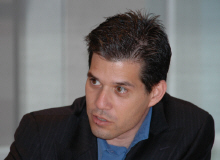SAP's Shai Agassi: Rewriting the book on business software


In my video interview with Agassi, he said that the software industry is in a transition period in which the fundamental rules governing platforms are changing, just as SAP's R/3 ushered in the era of client/server ERP. "The implications of SOA are not just a cool XML technology," Agassi said. "It means you get flexibility of business model unlike you've never seen before....When that book is written, no company will be able to sustain itself without this technology. It's the difference between running with email or without email, it's that fundamental." He added that the "company that will be there with enough stories, customers and proof points first is going to win the game. We started a lot earlier than everybody else, we are there already, we are delivering, the other guys are still writing PowerPoints."
The "other guys" referenced in Agassi's assessment of SAP's competitive status is Oracle. He dissed Oracle Fusion, the company's next-generation SOA platform due in 2008, as lacking a clear roadmap. He also said that he knows of no company that has converted from SAP to Oracle, despite Oracle's various marketing programs, including Off SAP, to attract users of older versions of SAP software. Oracle has a different opinion on its competition with SAP, citing much more growth than SAP in the last quarter, and plans to roll out more details on its Fusion strategy at Oracle OpenWorld in October. Oracle has some catching up to do. According to AMR Research, in 2005 Oracle captured 19 percent of the ERP applications market compared to 43 percent for SAP.
Agassi also outlined the roadmap for transitioning SAP applications to the new platform (4,000 of SAP's more than 30,000 customers still have R/3 contracts) and progress in seeding NetWeaver among developers. So far SAP has 500 'powered by NetWeaver' certified applications, Agassi said.
We also discussed Duet (SAP integration with Microsoft Office) and what SOA means in terms of building and customizing applications. SAP expects to produce about 3,000 Web services to cover all its applications across more than 20 industries. Customers won't be tasked with assembling thousands of services into applications like Lego blocks. SAP and its brethren will provide core "backbones" of applications, such as general ledger, and business processes, such as order to cash, with interfaces that make it easy to integrate with adjacent services and applications and to modify and compose business processes. The company is also working with customers and their software partners to capture the "long tail of services," which hook into the backbones with more specialized functionality.
The transition to SOA is clearly underway, and SAP has shown leadership, betting its future on a new core technology. But as in other technology transitions, customers tend to go at their own pace, especially when millions of dollars in transition costs are in play. According to Agassi, enterprises want a no-risk proposition, a comprehensive solution they can live with for seven to ten years. The new SOA platforms haven't reached the risk-free zone, but Agassi and team talk about taking an evolutionary approach to spreading the SOA gospel. When more proof points exist on how SOA platforms cut down on the integration and implementation taxes of the past generation of software, we'll be talking about what comes after SOA.